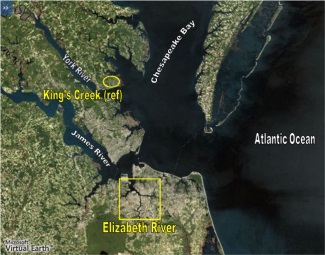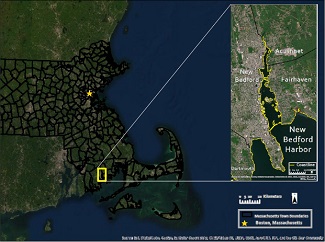By Adeline Lopez
Killifish populations have adapted to survive and reproduce in polluted waters. Researchers have studied the evolutionary and genetic basis for this adaptation, discovering that it comes with a cost.
For more than two decades, the Duke University Superfund Research Program (SRP) Center and collaborators at Boston University have used these 2- to 3- inch-long fish to understand the toxicity, mechanisms, and health effects of two groups of hazardous contaminants, polycyclic aromatic hydrocarbons (PAHs) and polychlorinated biphenyls (PCBs).

The Problem
PAHs and PCBs pollute air, water, and soil, and are linked to health problems in humans. The chemicals do not dissolve easily in water, but instead stick to solid particles and settle to the bottom of rivers, lakes, and estuaries.
To learn more about these chemicals, SRP-funded researchers at Duke and Boston University began studying contaminated sites on the East Coast. The Atlantic Wood Industries Superfund site in Virginia, which closed in 1992, is contaminated with a mixture of chemicals, including PAHs from the manufacture of preservatives used to treat wood. Runoff from the site has contaminated the nearby Elizabeth River. The New Bedford Harbor Superfund site in Massachusetts is contaminated with PCBs from the manufacture of electrical equipment. Even though manufacture and use of these contaminants have stopped at these sites, the chemicals remain in the environment.
SRP Solutions

Di Giulio (left) and Hahn (right) studied how prolonged exposure to contaminants over many generations leads to population-wide genetic changes. (Photos courtesy of the Duke SRP Center and WHOI)
Evolutionary Toxicology Provides Insights Into Adaptation
In 1995, Mark Hahn, Ph.D., senior scientist at Woods Hole Oceanographic Institution (WHOI) in Massachusetts, began an SRP-funded project at Boston University on the mechanisms and impacts of PCB resistance in killifish.
In 2000, Richard Di Giulio, Ph.D., initiated a project at Duke focused on understanding the mechanisms and consequences of killifish adaptation to PAHs. His early studies explored how fish adapt over many generations and whether adaptation was inherited through genes.

Jayasundara, who received SRP's prestigious Wetterhahn Award in 2015, took over the killifish project in 2022. (Photo courtesy of Nishad Jayasundara)
Today, former SRP trainee Nishad Jayasundara, Ph.D., is building on their work. He and his team are adding layers of complexity to explore the effect of multiple stressors and how the microbiome - the collection of microbes living inside an organism - and changes to gene activity play a role in fish adaptation.
"Scientifically, sustained funding is highly valuable for making new discoveries and continually putting pieces of the puzzle together on how a population of fish evolved resistance to chemicals in their environment," Jayasundara said. "It is a privilege to work on the same system for so long, and it is humbling to realize that we may barely be scratching the surface of the biological complexity around us."
Evolution and Cost of Adaptation
- Discovered that killifish resistance to pollutants is at least partly genetic.
- Analyzed how adapting to contaminants leaves killifish more susceptible to other stressors.
While leading the Duke team, Di Giulio compared fish from the polluted Elizabeth River with fish from unpolluted rivers and monitored their offspring for two generations in the lab. During this time, Di Giulio’s team continued to expose the fish to contaminated sediments from the Elizabeth River. Offspring of Elizabeth River fish were more likely to survive and less likely to have heart deformities, tail deformities, and other morphological issues resulting from PAH exposure than offspring of fish from a clean estuary in Virginia.

The Elizabeth River site is shown in the rectangle at the bottom of the map, with the unpolluted King’s Creek located to the north. (Map courtesy of Duke SRP Center)
However, fish resistant to PAHs were more sensitive to natural stressors like temperature increase, sunlight, and low oxygen. According to the team, the results point to an evolutionary tradeoff when fish adapt to pollutants.
Later, Di Giulio and team examined how early life chemical exposure affects killifish behavior. Embryos of non-adapted killifish exposed to contaminated water from the Elizabeth River had altered locomotion and behavior later in life while embryos of adapted killifish behaved typically. However, water with lower levels of contaminants did not affect behavior of non-adapted fish.
According to the authors, because adapted killifish evolved with Elizabeth River sediment, the sediment might be protective. That is, it might keep fish healthy by regulating bacteria and parasite populations, and even influencing the gut microbiome.
Similar to the earlier work, the researchers uncovered an associated cost of adaptation. For example, that when raised in unpolluted water in the lab, embryos of adapted fish faced higher mortality in the long-term.
Genome-Wide Association Studies and the Aryl Hydrocarbon Receptor
- Identified genes involved in contaminant resistance.
- Discovered genes in aryl hydrocarbon receptor (AHR) pathway that likely play a role in resistance.

New Bedford Harbor is shown in the yellow box on the map of Massachusetts. (Map courtesy of Boston University SRP Center)
Hahn’s team at WHOI focused on the biochemical changes behind PCB resistance in killifish. He studied the AHR signaling pathway, which regulates an animal’s biological response to chemicals. PCBs activate AHR to alter gene expression and cell function.
Hahn and colleagues found that killifish have as many as 98 variations in the DNA sequences coding for amino acids that make up the AHR protein.
Killifish from the polluted New Bedford Harbor had different genetic variations than killifish from unpolluted sites. The team hypothesized that the variants in adapted fish may create a nonfunctional AHR protein, thereby blocking the cascade of events characteristic of PCB toxicity. According to the researchers, the AHR pathway was likely an important genetic target driving PCB resistance.
Building on these findings, Hahn collaborated with others to sequence the genomes of almost 400 killifish. The genome-wide study involved four groups of fish from polluted sites and four groups of fish from unpolluted sites, to examine which parts of the genome were targets.
The team found genetic hotspots, or places in the genome that appeared to undergo natural selection in the pollution-resistant fish. The strongest hotspots appeared in all four groups of fish from polluted sites and included genes involved in the AHR signaling pathway, confirming their hypothesis about the link between contaminant adaptation and genetic variation in AHR.
In a similar study, Di Giulio’s group sequenced DNA of adapted and non-adapted killifish from the Elizabeth River and an unpolluted site. They identified eight places in the genome with unique variations in the adapted population. Like Hahn's team, Di Giulio’s lab identified genetic adaptation related to the AHR pathway, suggesting reduced AHR activation in response to PAHs also protects against toxicity.
By studying killifish, researchers can learn more about chemical toxicity in humans. Killifish and humans are vertebrates, and both utilize AHR pathways. Previous studies in mice, birds, and some fish show that variation in the AHR protein itself can control sensitivity to dioxin-like chemicals such as PCBs. Genetic variation in AHR in humans exists, but it does not fully account for differences in chemical susceptibility or resilience. In their studies, Hahn and Di Giulio found that other genes encoding proteins in the AHR pathway may contribute to variations in sensitivity, and the same could be true for humans.
Integrating and Sharing Data
Hahn and Di Giulio received an SRP data supplement to collaborate on integrating their genomic data to better understand mechanisms of susceptibility and their inheritance.
With the supplement, the researchers integrated the Hahn team’s whole-genome data from 384 killifish with Di Giulio’s sequenced genome samples from 270 fish. Initial analyses of data from both projects identified variation in the AHR signaling pathway as a common feature associated with pollution resistance.
The team made data available on an open-source genome browser, allowing researchers to link killifish data with animal and human data to look for similar genes across species, which could help further explain genetic susceptibility to hazardous substances.
What's New?
Under Jayasundara's leadership, the Duke SRP Center team is focusing on the mechanisms by which pollution adaptation can affect overall fitness in killifish. For example, they found that differences in metabolic rates between PAH-resistant and PAH-sensitive fish can manifest later in life. From there, they began examining the role of mitochondria as an important target of chemical exposures early in development that can have major impacts in subsequent generations.
Jayasundara and team are also looking at how exposure to multiple chemicals or other stressors comes into play.
"We're exploring how organisms respond to exposure to more than one chemical in a natural environment and how evolved resistance to one chemical affects their response to another chemical," Jayasundara said. "By combining PAHs with exposure to cadmium or lead and environmental factors like temperature and oxygen levels, we hope to better understand how the fish respond to their complex natural environment."
The team is also pursuing another question: how the fish microbiome influences adaptive resistance to PAHs.
"This is an exciting new area of emerging research, with human and ecological health implications," Jayasundara noted. "We have reported shifts in microbial composition related to exposure that may explain some of the other differences we've observed between PAH-adapted and PAH-susceptible fish."
Citations
Carvan M. 2007. Roundtable discussion: Fish models in toxicology. Zebrafish 4(1):9-20. doi: 10.1089/zeb.2006.9998
Brown DR, Bailey JM, Oliveri AN, Levin ED, Di Giulio RT. 2016. Developmental exposure to a complex PAH mixture causes persistent behavioral effects in naive Fundulus heteroclitus (killifish) but not in a population of PAH-adapted killifish. Neurotoxicol Teratol 53:55-63. PMID: 26548404
Di Giulio RT & Clark BW. 2015. The Elizabeth River Story: A Case Study in Evolutionary Toxicology. J Toxicol Environ Health B Crit Review 18(6):259-298. PMID: 26505693
Meyer JN, Di Giulio RT. 2003. Heritable Adaptation and Fitness Costs in Killifish (Fundulus heteroclitus) Inhabiting a Polluted Estuary. Ecological Society of America 13(2):490-503. doi: 10.1890/1051-0761(2003)013[0490:HAAFCI]2.0.CO;2
Osterberg JS, Cammen KM, Schultz TF, Clark BW, Di Giulio RT. 2018. Genome-wide scan reveals signatures of selection related to pollution adaptation in non-model estuarine Atlantic killifish (Fundulus heteroclitus). Aquat Toxicol 200:73-82. PMID: 29727773
Reid NM, Proestou DA, Clark BW, Warren WC, Colbourne JK, Shaw JR, Karchner SI, Hahn ME, Nacci D, Oleksiak MF, Crawford DL, Whitehead A. 2016. The genomic landscape of rapid repeated evolutionary adaptation to toxic pollution in wild fish. Science 354:1305-1308. PMID: 27940876
Reitzel AM, Karchner SI, Franks DG, Evans BR, Nacci DE, Champlin D, Vieira VM, Hahn ME. 2014. Genetic variation at aryl hydrocarbon receptor (AHR) loci in populations of Atlantic killifish (Fundulus heteroclitus) inhabiting polluted and reference habitats. BMC Evol Biol 14:6. doi: 10.1186/1471-2148-14-6
Redfern LK, Jayasundara N, Singleton DR, Di Giulio RT, Carlson J, Sumner SJ, Gunsch CK. 2021. The role of gut microbial community and metabolomic shifts in adaptive resistance of Atlantic killifish (Fundulus heteroclitus) to polycyclic aromatic hydrocarbons. Sci Total Environ 776:145955. PMID: 33647645
Jasperse L, Di Giulio RT, Jayasundara N. 2023. Bioenergetic Effects of Polycyclic Aromatic Hydrocarbon Resistance Manifest Later in Life in Offspring of Fundulus heteroclitus from the Elizabeth River. Environ Sci Technol 57(42):15806-15815. PMID: 37818763
Kozal JS, Jayasundara N, Massarsky A, Lindberg CD, Oliveri AN, Cooper EM, Levin ED, Meyer JN, Giulio RTD. 2023. Mitochondrial dysfunction and oxidative stress contribute to cross-generational toxicity of benzo(a)pyrene in Danio rerio. Aquat Toxicol 263:106658. PMID: 37722151


